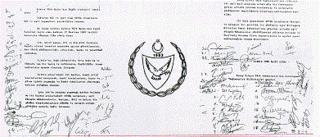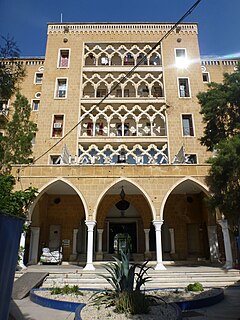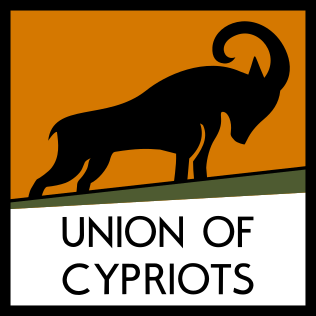 W
WThe Cyprus dispute, also known as the Cyprus conflict, Cyprus issue, or Cyprus problem, is an ongoing dispute between Greek Cypriots and Turkish Cypriots. Initially, with the occupation of the island by the British Empire from the Ottoman Empire in 1878 and subsequent annexation in 1914, the "Cyprus dispute" was identified as the conflict between the people of Cyprus and the British Crown regarding the Cypriots' demand for self-determination. The British administration shifted the dispute from a colonial dispute to an ethnic dispute between the Turkish and Greek islanders.
 W
WThis article is about the history of Cyprus from 1878 to the present.
 W
WIn 2011, a series of rallies were held by Turkish Cypriots in North Nicosia against Turkey's policies on Cyprus.
 W
WAgios Georgios Soleas is an abandoned village due to the turkish invasion in Cyprus in 1974 in the Nicosia District of Cyprus, and it lies within the UN Buffer Zone. In 1960, the village had a population of 460; 312 identifying themselves as Greeks, 143 identifying themselves as Turks, and the other 5 not indicating an ethnicity or of mixed heritage. The population declined to zero by 1980 due to the placement of the Buffer Zone and the village was still abandoned at the time of the 2001 census.
 W
WAgios Nikolaos Lefkas is an abandoned village in the Nicosia District of Cyprus, and it lies within the UN Buffer Zone. In 1946, the village had a population of 132. This declined to 67 by the time of the 1960 census and the village was abandoned altogether with the creation of the UN Buffer Zone.
 W
WThe Republic of Cyprus (Cyprus) and Turkey have been engaged in a dispute over the extent of their exclusive economic zones (EEZ), ostensibly sparked by oil and gas exploration in the area. Turkey objects to Cypriot drilling in waters that Cyprus has asserted a claim to under international maritime law. The present maritime zones dispute touches on the perennial Cyprus and Aegean disputes; Turkey is the only member state of the United Nations that does not recognise Cyprus, and is one of the few not signatory to the United Nations Convention on the Law of the Sea, which Cyprus has signed and ratified.
 W
WThe declaration of Independence of the Turkish Republic of Northern Cyprus was a unilateral declaration of independence from the Republic of Cyprus by the Turkish Cypriot parliament on 15 November 1983.
 W
WThe Ecclesiastical coup is the name given to the events staged by three bishops of the Orthodox Church of Cyprus against the President of the Republic of Cyprus, Archbishop Makarios III, in the period from March 1972 to July 1973.
 W
WAn international embargo against Northern Cyprus is currently in place in several areas. The embargo is supported by the policy of the United Nations and its application by the European Union is in line with a European Court of Justice (ECJ) decision taken in 1994.
 W
WEnosis is the movement of various Greek communities that live outside Greece for incorporation of the regions that they inhabit into the Greek state. The idea is related to the Megali Idea, an irredentist concept of a Greek state that dominated Greek politics following the creation of modern Greece in 1830. The Megali Idea called for the annexation of all ethnic Greek lands, parts of which had participated in the Greek War of Independence in the 1820s but were unsuccessful and so remained under foreign rule.
 W
WThe Ethniki Organosis Kyprion Agoniston was a Greek Cypriot nationalist guerrilla organisation that fought a campaign for the end of British rule in Cyprus, for the island's self-determination and for eventual union with Greece.
 W
WAnastasios "Tassos" Isaac, was a Greek Cypriot refugee who participated in a civilian demonstration against the Republic of Turkey's military occupation of the northern part of the Republic of Cyprus. The demonstrators' demand was for the complete withdrawal of Turkish troops from the island, and the return of Cypriot refugees to their homes. Isaac was beaten to death by a mob of Turkish far-right ultranationalists of the Grey Wolves in the United Nations Buffer Zone in Cyprus.
 W
WThe Ledra Palace Hotel is located in central Nicosia, Cyprus, and until 1974 was one of the largest and most glamorous hotels of the capital. The hotel was designed by the German Jewish architect Benjamin Günsberg and was built between 1947 and 1949 by Cyprus Hotels Limited at a cost of approx £240,000 Cyprus pounds on what was then called King Edward VII Street, since 1962 Markos Drakos Avenue. The hotel opened on 8 October 1949 in the presence of British Governor Sir Andrew Wright and Vice Mayor of Nicosia George Poulios. It originally had 94 bedrooms and 150 beds, officially rated as de luxe. All rooms had hot and cold water, central heating and a telephone. Facilities included a conference, reading, bridge and ballroom with orchestra. There were two restaurants, two bars and café. Located within the garden was a swimming pool, paddling pool, children's playground and tennis courts. The hotel had two additional floors added in 1967–1968, thus raising its capacity to 200 rooms and 320 beds.
 W
WThe London and Zürich Agreements for the constitution of Cyprus started with an agreement on the 19 February 1959 in Lancaster House, London, between Turkey, Greece, the United Kingdom and Cypriot community leaders. On that basis, a constitution was drafted and agreed together with two further Treaties of Alliance and Guarantee in Zürich on 11 February 1959.
 W
WMaratha, Santalaris and Aloda massacre refers to the massacre of Turkish Cypriots by EOKA B on 14 August 1974 during the Turkish invasion of Cyprus in the villages of Maratha, Santalaris and Aloda. 89 people from Maratha and Santalaris were killed, and a further 37 people were killed in the village of Aloda. In total, 126 people were killed during the massacre. The massacre occurred shortly after the start of the second Turkish invasion, concurring with other massacres.
 W
WNorthern Cyprus nationality law is the law governing the acquisition, transmission and loss of Northern Cyprus citizenship. Naturalized Northern Cyprus citizens are persons granted citizenship by the de facto Government of Northern Cyprus, which is recognized only by Turkey.
 W
WSolomon Solomou was a Greek-Cypriot who was shot and killed by a Turkish officer while trying to climb a flagpole in order to remove a Turkish flag from its mast in Cyprus's United Nations Buffer Zone. The killing occurred in the aftermath of the funeral of Solomou's cousin Tassos Isaac, who had been murdered a few days earlier by Turkish nationalists belonging to the militant Grey Wolves organization.
 W
WTaksim was the objective of Turkish Cypriots who supported a partition of the island of Cyprus into Turkish and Greek portions, a concept declared as early as 1957 by Dr. Fazıl Küçük.
 W
WThe Turkish Cypriot enclaves were inhabited by Turkish Cypriots between the intercommunal violence of 1963–64 and the 1974 Turkish intervention of Cyprus.
 W
WIn order to find a solution to the Cyprus dispute, which started in 1963, numerous plans and meetings in international arena were organized and eventually United Nations determined the solution to be "bi-zonal and bi-communal federation" based on the political equality of Greek Cypriot and Turkish Cypriot people. According to United Nations' 2004 Annan Plan for the reunification of Cyprus, the proposed United Cyprus Republic would consist of two constituent states, the Greek Cypriot State and Turkish Cypriot State, which would be governed by Greek Cypriots and Turkish Cypriots respectively.
 W
WThe Turkish invasion of Cyprus, code-named by Turkey as Operation Atilla, was launched on 20 July 1974, following the Cypriot coup d'état on 15 July 1974.
 W
WThe Turkish Resistance Organisation was a Turkish Cypriot pro-taksim paramilitary organisation formed by Rauf Denktaş and Turkish military officer Rıza Vuruşkan in 1958 as an organisation to counter the Greek Cypriot Fighter's Organization "EOKA"(later "EOKA-B"). The name of the organization was changed twice. In 1967 to "Mücahit", and became the Security Forces Command in 1976.
 W
WThe Union of Cypriots is a Cypriot nationalist, progressive political organization in Cyprus. The Union of Cypriots campaigns for a unitary Cypriot state, the restoration of the constitutional order that was destroyed in Cyprus after the crisis of 1963-64 and the ending of the Turkish occupation of Cyprus.